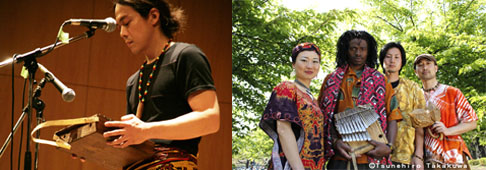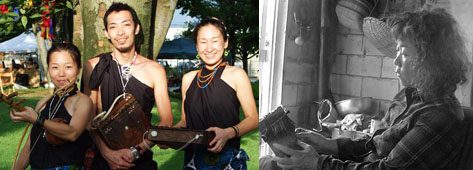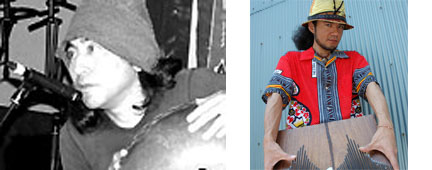2010年9月29日
9/26ムビラの日レポート
記念すべき第9回ムビラの日が開催されました。
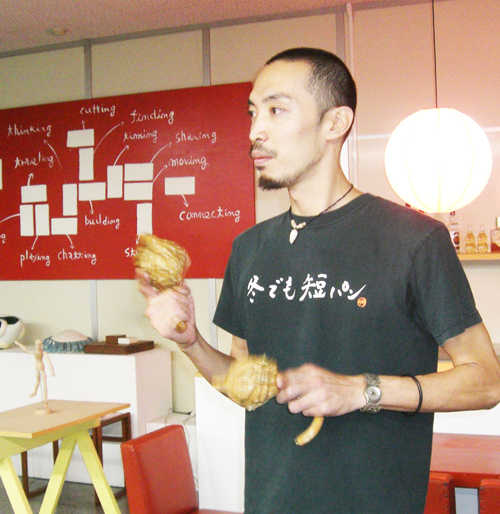
前回に引き続き、ホショ練習が熱いです。
お菓子を食べて喋ってるだけに見えますが、手元にご注意ください。激しく練習中です。
今月のNhemamusasa
かなりいい感じです。このグルーブ感で10月10日開催のMbira Music Festial に挑みます!
皆様ぜひお越しくださいませ!!
2010年9月29日
9/25 ムビラフェスティバルの巨大タペストリー作った!
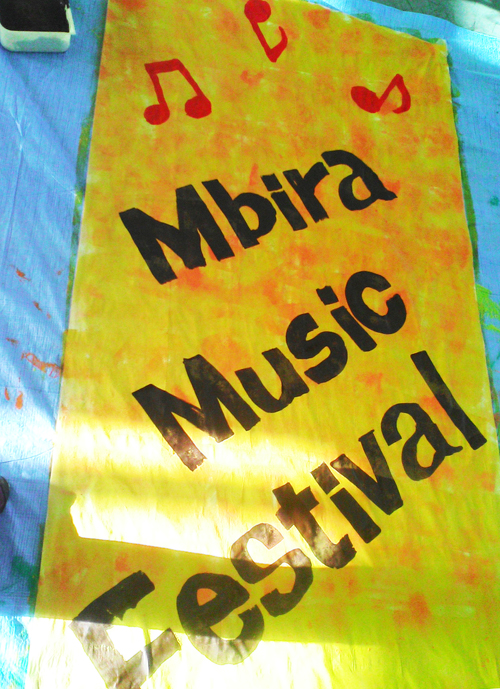
10月10日Club Q2で開催されるMbira Music Festivalの会場を飾るタペストリー作りをしました。
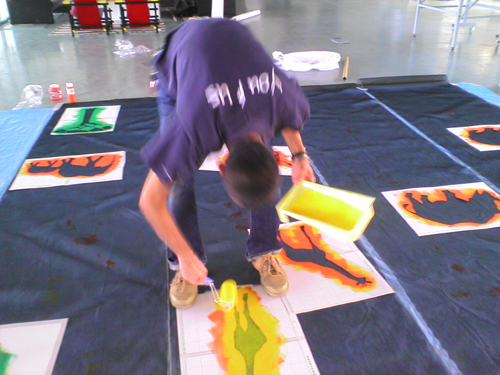
予めフェスティバル実行委員長が作っておいたアフリカの動物シリーズの型でステンシルしています。
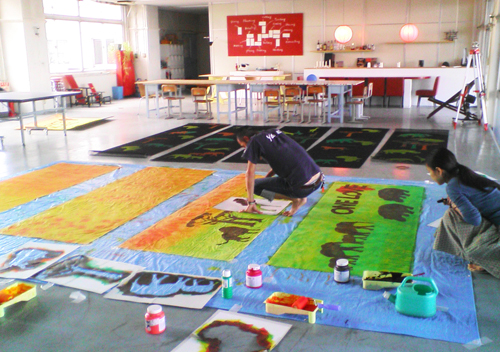
予定していた以上に盛り上がってしまい、多分全部で50メートルくらいのタペストリーを作りました。
フェスティバル当日はこれらが会場をアフリカ気分で一杯にしてくれることでしょう。
前売りチケット予約まだの方はこちら
ワークショップもまだ空きがあります。
詳しくはMbira Music Festivalご覧下さい
2010年9月29日
9/24(金) A la Merと 卓球部
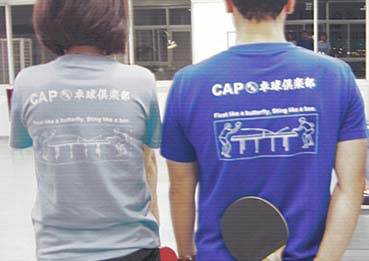
卓球部のTシャツができた!
上村会長デザインの卓球Tシャツです。
蝶のように舞い、蜂のように刺せ!と背中で言ってます。
欲しいでしょ?
2010年9月28日
9/18 Hiros and Friends at Club Q2
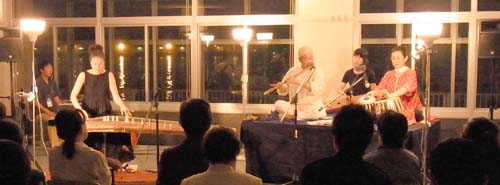
Sometimes it's hard to tell where one thing ends and another begins. Random conversations occur and we are tempted to think of them as isolated and discrete events. This isn't always the case.
One evening in spring, I was leaving Studio Y3 walking to Sannomiya Station. It happened that Hiros was leaving at the same time. We went out together into the night. What followed was one of those rather rare conversations.
We quickly passed through the customary pleasantries and onto a subject Douglas Adams might have called, "life, the universe and everything" This included a few brief remarks about years Hiros spent living and studying traditional music at an international program in India along the Ganges river. During that conversation, he never intimated that there was anything more to say on the subject. However, I later learned that what he had to say that evening about the music he performs was just the tip of the iceberg.
A couple of years ago, Hiros and Shimoda Nobuhisa san (Director of C.A.P.) had a conversation about the state of Japanese Traditional Music in contemporary Japan. During that conversation, Hiros said that while in India it was common for the international students (of which he was one) to gather together at the end of the day and discuss music. Typically, they might have talked about the traditional music of their respective home countries. Hiros felt that he was dissatisfied with what he knew about Traditional Japanese Music. Furthermore, upon reflection, he realized that many Japanese had no informed appreciation of their Traditional Music.
Since the Meiji Restoration, European education models replaced traditional Japanese education. Music education in Public schools too underwent the same transformation, and with this, a general knowledge of Japanese musical culture faded. Hiros wanted to change this and to go further. So the two men, Hiros and Shimoda san, decided to create a concert series that presented Traditional Music for the public, but they wisely recognized that without an energetic context, such performances might seem rather dull for newer audiences. So they have encouraged the participation of diverse musical talents. These have been musicians who not only appreciate traditional musical culture, but also recognize that to thrive and grow a fusion between the old and the new must be lively and ongoing. The concert series invites the participation not only of musicians, but also of composers.
So on the evening of September 18th, I stepped off the Port Liner at Port Terminal Station and followed the signs down the stairs to Studio Q2 (one of two studios operated by C.A.P.). It was twilight and the early darkness hovered outside the wall of glass that gave a nearly uninterrupted view of the harbor. From across the water, one could see the distant lights of buildings and cars as well as the occasional airplane and passing ships.
I have to confess that the lighting, the view and the intimate setting leave one with a sense that something exceptional is about to begin and if that is your sense, you will not be disappointed. The format of these concerts is simple. An introduction of the music (it used to be a lecture) followed by the performance. Rather than having a stuffy, formal sense (as could easily happen) these intros are skillful, lighthearted and helpful. I think this is largely due to Hiros-san's thorough command of his subject and the grace of his unvarnished personality.
This was the second of six concerts in this series that I had attended (see the 9/18 entry at: https://www.cap-kobe.com/club_q2/ ). The first was a year ago, almost to the day. On that occasion, Hiros-san presented with a chorus of monks called the Shichiseikai performing music known as Shomyo. Also accompanying him that evening was Tanaka Riko-san playing tabla. On that evening, I learned not to expect the ordinary. I remember leaving the venue and saying to my wife and daughter that I had never experienced anything like it. This evening was no different.
The first piece was a composition for flute and koto. The koto was played by Fukuhara Sawako-san, a world renown koto musician. It was a beautiful selection. As the first notes rose into the room, they seemed to change the sense of where we were. It was a kind of transformation. What I noticed was the way everyone in the room became captive to the sound. It also became immediately conspicuous that Sawako-san was very precise and strong.
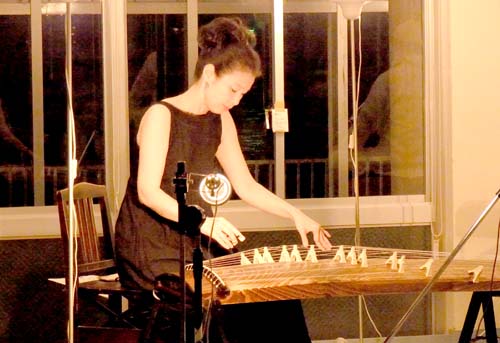
The second selection was equally strong. With that, it became obvious that the choices made around the selection of works was clear and forceful. These concerts are not soft surveys of a musical genre: They are rigorous and energetic. Through the choices I felt we were being led toward an understanding of the richness and flexibility of this music.
The following four pieces carried this theme of richness and flexibility forward and added to the ensemble the Tabla played by Riko-san as well as the electric and acoustic Tabula played by Ishio Maho-san.
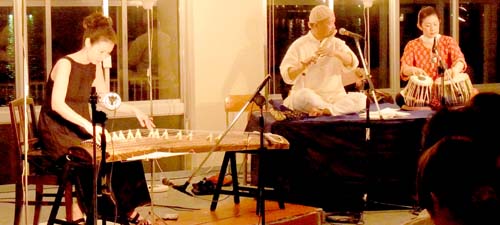
It's important to say that several times throughout the concert, I had the feeling of witnessing
one of those great performances of the early Jazz era. The room was full of admiration and affection for a vital and sometimes breathtaking sound.
The evening ended the way you might expect, an enthusiastic audience gathering around to express their appreciation for a beautiful evening. It was difficult to leave without saying something to these wonderful artists.
This concert series is a great contribution to the cultural life of Kobe. To write about it, I think, demands that I give our readers a little more depth. So I will be writing about this again. With luck, the conversation I thought was random and isolated will be only the beginning.
2010年9月26日
10/29(金)A la Mer 〜 海のうえで
10/29のアラメールは旧生糸検査所でおこなうことになりました。
参加ご希望の方はメールでご予約ください。
参加ご希望の方は事前にご予約ください。
電子メールでプログラム名、お名前、連絡先をお知らせ下さい。
ご予約はここをクリック
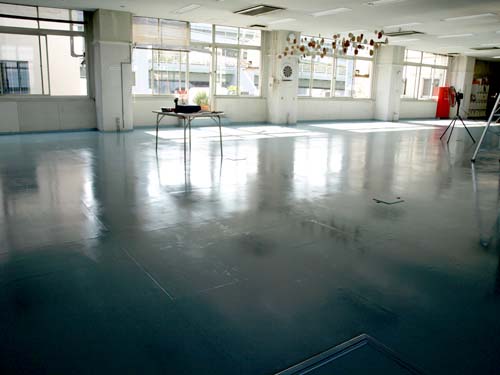
A la Mer〜海のうえで2010年10月29日(金)17:00〜
場所:旧生糸検査所4階南の部屋(twist&shoutでリレートークをした部屋です)
参加費:¥1,000(宅配ピザを用意します)
要予約twist&shoutの後のリビングルームでの特別版です!
11月からは改修工事に入るこの建物をゆっくりたのしんでください。
予約が必要です。
2010年9月26日
10/16(土)Q2プラモ部「トミー先生の複製講座」第2弾
ご予約は電子メールでお願いします。
お名前、イベント名、予約人数をお知らせ下さい。
ご予約はこちらから
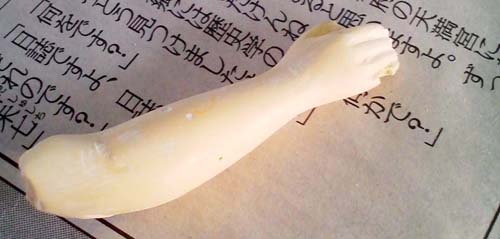
Q2プラモ部「トミー先生の複製講座」第2弾2010年10月16日(土)13:00〜
講師:トミー先生
参加費:¥1,000(1ドリンク付)
親指大までで溶剤が付着してもよい複製したいものを持参してください。10月のプラモ部も引き続き複製講座です。
もちろん、普通のプラモ製作もやっています。
皆さんの参加、お待ちしております。
2010年9月26日
10/16イラスト部「ポスターを描こう その2」
ご予約は電子メールでお願いします。
お名前、イベント名、予約人数をお知らせ下さい。
ご予約はこちらから
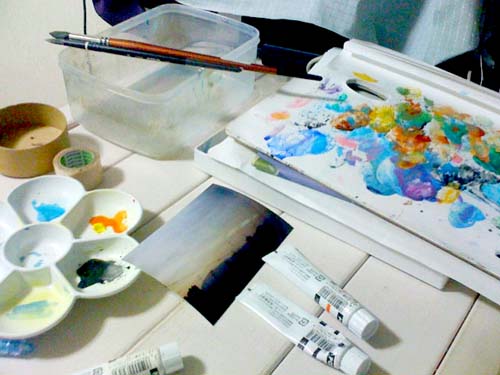
イラスト部「ポスターを描こう!(その2)」
2010年10月16(土)13:00〜
キャプテン:早川梓
参加費:¥1,000(1ドリンク付)
大っきい紙と大っきな筆でざくざく絵を描きましょう。今回は2回目です。前回失敗して紙破いちゃったり汚しちゃったりした方! 今回はそんな失敗を挽回しましょう。まぁ、紙、破けても全然アートだと私は言い張るけどね!
2010年9月26日
10/10(日)Mbira Music Festival
Africaの親指ピアノ Mbira Music Festial in Kobe
2010年10月10日(日)10:00〜22:00
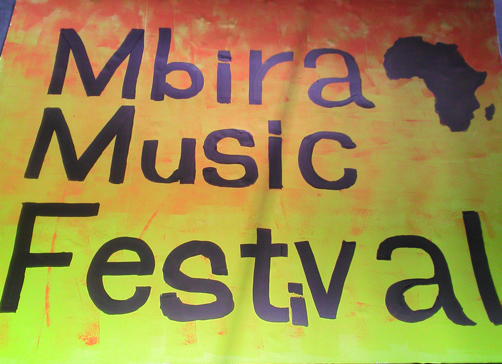
朝から晩まで遊べるアフリカの親指ピアノのお祭りです。
ワークショップあり、マーケット有り、ライブ有り。
もちろん途中から途中までの参加もオッケー、ライブだけ、ワークショプだけ、マーケットだけに遊びにくるのもありですよ!
絶対楽しい!!詳しくは http://mbirafestival.blog114.fc2.com/
各種ワークショップ参加:¥500〜 ライブ:前売予約¥3,000 当日¥3,500
ムビラフェスティバル実行委員会
メールでこちらまで
もしくはお電話で090-7364-6676 中村まで
出演者&ワークショップ講師紹介
左写真 玄音 solo (スズキヤスハル)
タンザニアの太鼓ンゴマとゴゴ族の親指ピアノイリンバの演奏。現地で学んだことをベースに独自の感覚でアレンジ右写真 パシチガレ・ムビラズ
左から、ハヤシエリカ(紙芝居とムビラ文化のお話講師)、 トンデライ・ティリコティ(ショナ語と歌、ホショ、ダンス講師)、スミ、マサ
ジンバブエの伝統的ムビラでもチューニングが違う複数台のムビラで演奏するトンデライ氏の家族の演奏スタイルの再現を目指す。
左写真 JT☆STARS(アフリカごはん体験講師)
左から、イエズ、シロー、チエ。タンザニア、ゴゴ族の指ピアノ、リンバや弦楽器、ゼゼを使って伝統音楽をアレンジした曲や、オリジナル曲などを演奏右写真 近藤ヒロミ
指ピアノ奏者の草分け的存在。ジンバブエのムビラ、タンザニアのリンバ、など、長期にわたるアフリカ放浪で身につけた音は現地の風を運んでくる。沖縄在住、ソロ、ユニット、など多岐に活躍
左写真 熊越シンヤ(ムビラを弾こう!講師)
03年にムビラジャンクション設立、全国各地を回ってライブやワークショップを行ないムビラの普及活動を行ってきた。スライドと映像、サウンドで、ジンバブエの最もフレッシュな情報と、音楽を紹介右写真 サカキマンゴー(ムビラーにも最適!親指ピアノ講師)
今や大ブレイク。この夏は、昨年度ヨーロッパのミュージックチャートNo.1になったChiwoniso Maraireを含むアフリカ人気アーティスト達とSUKIYAKI ALL STASを結成、韓国ツアーも行った。言わずと知れた親指ピアニスト
写真左 ジョゼフ・ンコシ(マリンバアンサンブル体験講師)
南アフリカで3本の指に入るマリンバ(木琴)奏者。ネルソンマンデラ大統領をはじめとする著名人のまえで、南アフリカを代表して数多く演奏してきた。
マリンバの他に、ダンスやジャンベ、そしてアートの世界でも一流の腕を持つ。
パートナーのともみを含むメンバー二人も参加写真右 チョコリンガーズ
西嶋俊介、永田翔平、実近修平(ムビラで踊ろう講師)、石村行(ムビラの世界の入口に案内講師)からなる 。
メンバー全員ジンバブエのムビラ名手SIMBOTIに学び、現地の伝統的ムビラの演奏を再現
ティリコティ和歌子(原色つぶつぶマジック!ビーズワーク体験講師)
ティリコティ家族の元で生活し、ムビラ奏者としてもパートナーのトンデとともに演奏活動をしている。
アフリカで吸収したビーズテクニックを伝授
2010年9月23日
9/18 日本の筝とインドの笛、すばらすぃかった

9月18日の土曜日、筝の福原左和子さんを迎えての「日本とインドの音楽」コンサートがおこなわれました。
福原さん、すばらしい!
すごい演奏でした。来れなかった方は、残念!としかいいようがありません。

福原さんの演奏では現代曲を2曲披露してくれました。スーパーテクニックでした。
でも、さらに圧巻はインド音楽とのセッションでありました。
筝のピッキングとタブラーの音が絡まりつつ、バーンスリーと筝の旋律が清流を走る2尾のマスのようでありました。
Hirosさんはこのセッションの為に新しい曲を作ったそうですよ。

お客さんは、みなさん喜んでました。そりゃ、すごい演奏だったのです。
さて、次は11月13日の土曜日、午後7時から、尺八の石川利光さんを招いてのコンサートです。
最近は虚無僧の世界に入り込んでいらっしゃるとか。。。虚無僧がインド人と会ったらどんな音楽で会話するのか?
みなさん予定を今から予定を空けておいてください!
2010年9月 8日
9/18(土)日本とインドの音楽 ;これまでの企画
2010年9月18日にQ2で、日本とインドの音楽シリーズ第二回として筝の福原左和子さんをゲストにHirosさんとのコンサートを開催します。
昨年「インド音楽のレンズを通して見えてくるアジア的音楽の可能性」シリーズを行なって、参加された方たちから「面白かった。もっと演奏を聴かせて欲しい。」という要望をいただきました。
そこで今年は、同シリーズの趣旨はそのままに、インドの古典音楽と日本の様々な音楽を聴き、また両者の実験的なセッションを主体に「日本とインドの音楽シリーズ」として全4回のコンサートシリー
ズを実施中です。
インド古典音楽の演奏と研究における日本の第一人者、中川博志さんが、日本音楽の優れた演奏家と直接交渉してはじめて実現した、日本でも他に類を見ない試みだと思います。
昨年のシリーズから通算で、9月18日の「日本の筝とインドの笛」が6回目になります。
これまで毎回「いったいどうなるんだろう!?」というスリルに満ちた企画でした。
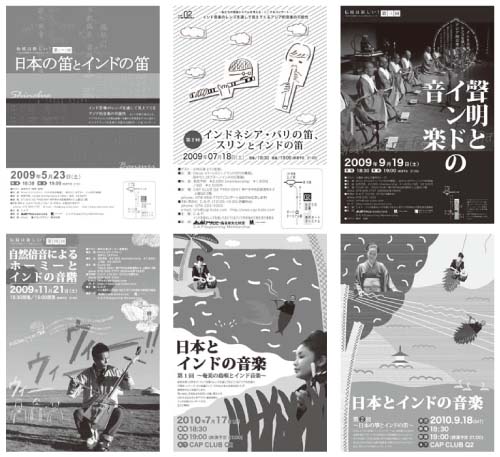
昨年実績をちょっと振り返ってみると、、、、、
〜私たちの音楽システムを考えるシリーズ
「インド音楽のレンズを通して見えてくるアジア的音楽の可能性」
【シリーズ企画趣旨】
われわれのまわりには西洋のハーモニー(和音)を基本としたパッケージ化した消費音楽があふれている。コードの組み合わせから簡単な曲を作るテレビ番組もある。しかし、そうした「普通」のやり方とは違った音楽を創造するシステムは世界中にある。とくにインドの音楽は、コードをまったく使わずにいかに変化に富んだ即興的メロディーを作り出すか、という考え方に基づいて緻密なシステムを作り上げ、豊かな音楽文化を誇ってきた。このインドの音楽システムは、日本や他のアジアの音楽の理解や、西洋のやり方とは違った音楽の創造に非常に有効なのではないか。シリーズでは、こうしたインドの音楽システムに基づく即興音楽のあり方の理解と、アジアを中心とした音楽を演奏する優れた音楽家をゲストに迎えてオルタナティブな音楽の可能性を提案していくことを目的としている。
第一回 5月「日本の笛とインドの笛」ゲスト:森美和子さん(篠笛)
第二回 7月「インドネシア・バリの笛、スリンとインドの笛」:ゲスト:小林江美(バリ音楽)
第三回 9月19日(土)「聲明とインドの音楽」ゲスト:浄土宗聲明グループ「七聲会」
第四回 11月21日(土)「自然倍音によるホーミーとインドの音階」 ゲスト:岡林立哉(ホーミー演奏家)
そして今年の7月に行った奄美の島唄。
「日本とインドの音楽」4回シリーズ 2010
昨年の「インド音楽のレンズを通して見えてくるアジア的音楽の可能性」シリーズ・コンサートの続編として、今回はとくに日本の音楽を取り上げる。インドのラーガ(音階)を基礎とした即興性の強い音楽と、さまざまな日本の伝統的音楽との間にはとくに強いつながりはない。しかし、意識的なハーモニーをもたない、一定の拍節をもたない自由リズムのメロディーが多い、という点では同じアジアの音楽として共通する点も多い。今回は、奄美島唄、筝、尺八、篠笛の優れた演奏家をゲストに招き、その共通点を聴き比べ、日本とインドの音楽の奥深さと西洋音楽的手法とは異なるパフォーミング・アーツを味わっていただくことを目的とした。
レギュラー出演者:HIROS(ナビゲーター+バーンスリー)、田中りこ(タブラー)、石尾真穂(タンブーラー)
第1回 7月17日(土)「奄美の島唄とインド音楽」 ゲスト:榮百々代(さかえももよ、奄美島唄)
さて、いよいよ9月18日土曜日に、気鋭の筝奏者、福原左和子さんを招いて、今年のシリーズ2回目です。日本の筝とインドの笛をお楽しみに。
前売予約はメールでお早めにどうぞ。
2010年9月 6日
8/29ムビラの日レポート
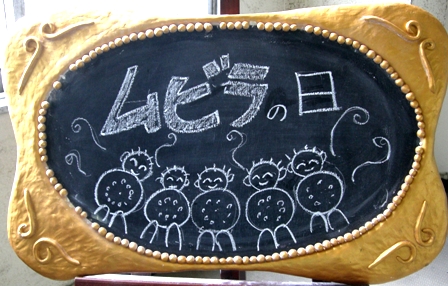
記念すべき第8回ムビラの日が開催されました。
今月もタケちゃんに看板書いてもらいました。
10月10日にQ2で開催されるムビラフェスティバルのフライヤーデザインもタケちゃんです。
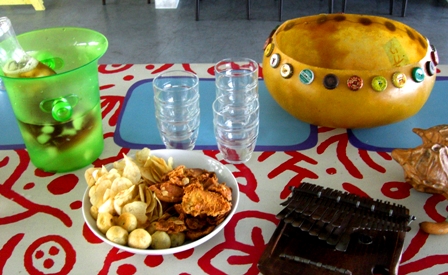
猛暑を避けて昼下がりからの開催ということで冷たいお飲み物とお菓子をご用意いたしました。
そしてもちろんムビラミュージックも!
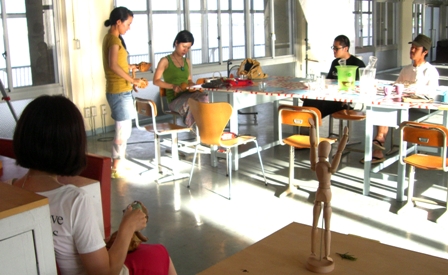
ムビラミュージックを聞いているうちに自然とホショ練習が始まります。
ホショはひょうたんに花の種が入ったマラカスで、合奏する際に重要な役割をもっています。いわゆる指揮者のようなものです。
片方で拍をズと刻みもう一方で、中の種をまわして、ザーというリズムを入れます。
簡単そうに見えますがかなりの修練が必要です。
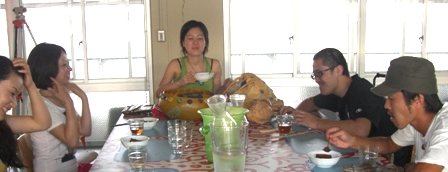
今週もお料理上手な真ん中のムビラーがデザートを作ってきてくれました。
みんなでおいしいチョコレートスフレを食べながら幸せな夕暮れ時です。
今月のNhemamusasa
さて、ホショ練習の効果はいかに?
おしいです。きれいに刻めているのにホショの位置がクチニラというパートが入ったとたんずれてしまっています。
演奏しているのがジンバブエ人であれば確実に演奏が止まってしまいます。
なんとか成り立っているのは、みんなホショを聞かずに、音だけで合わせてしまっているからなのですね。
ムビラーの皆さんどこが間違っているかわかりますか?
正しいホショはこちらです。




